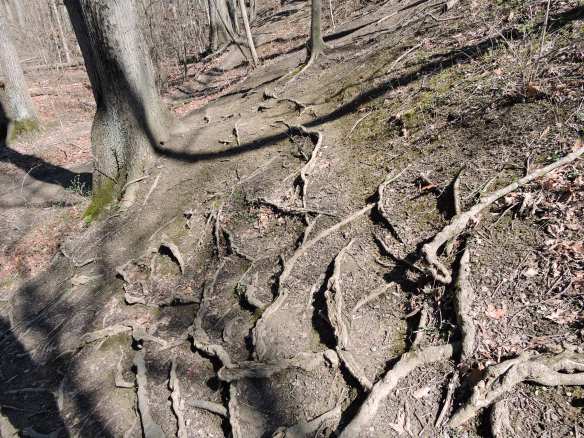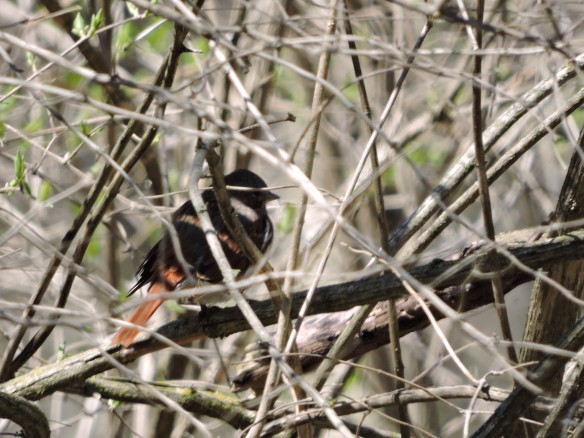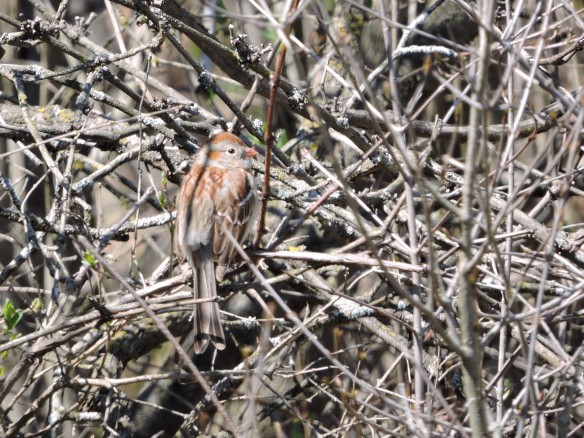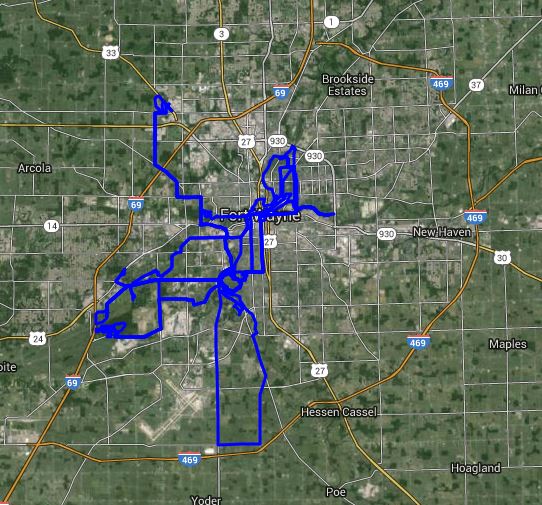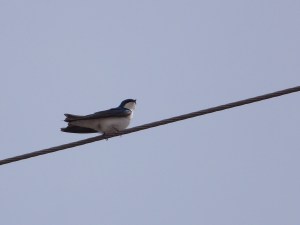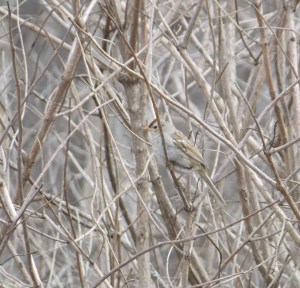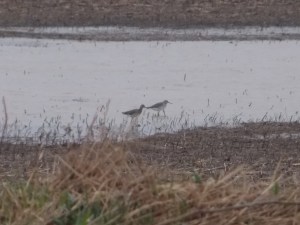On Wednesday, most people in my office went down to Indy for pre-500 festivities. Since that is not my thing at all, I decided it would be the perfect day to undertake a green big day, which is something I have been wanting to do for a while. Last year I did a day-long ride, but I wasn’t strategic about maximizing the number of species, and I definitely did not prepare well enough. So I put a plan together and got everything ready the evening before.

Provisions
Pictured above: my binoculars (Vortex Diamondback 8×42), camera (Nikon Coolpix P600), notepad, pen, house key, driver’s license and credit card for emergencies, two dollars in change to pay the Fox Island admission fee, a pair of extra socks, sunscreen, bug spray, bike lock, hat, sport bottle, a big thing of PowerAde that was in my fridge for like a year, three liters of water, three Cliff bars, a bag of trail mix, and two peanut butter sandwiches. Not pictured: my phone and a multi-tool. Oh, and also my bike. All of this fit into my trunk bag and panniers and wasn’t really that difficult to lug around all day.
Last year on my long ride I went just about as hard as I could in between birding stops to maximize time, and it ended up costing me. I hit a wall in the early afternoon that was due to a combination of a lack of calories and dehydration, so this supply list was built mostly to keep that from happening again. I decided to pace myself, take it easy on the rides, and do a lot of birding while actually on my bike.
I left home just after 4:30am on Wednesday with my plan being to make it to Fox Island before sunrise to rack up as many singing migrant passerines as possible, and then do mop-up duty on grassland and marsh birds at other nearby locations as needed. I netted my first bird of the day, a singing American Robin, while I was still in the garage, and my first new green bird came just a few minutes into my ride as I heard a calling Common Nighthawk over my neighborhood. As I rode through downtown heading toward Fox Island, I continued to build my list with surprising additions of Yellow Warbler and Gray Catbird singing vigorously in the pre-dawn. I made it to the towpath trail near Eagle Marsh and then got a county bird as an American Woodcock peented from somewhere far off in the grass. Things were going well, so naturally I ditched my planned route all together.

The sky was all purple, there were people running everywhere…
I instead stopped at the east end of Eagle Marsh to listen for what would be my only shot at rails and bitterns. I struck out on those, but I picked up several year birds and enjoyed a pretty great sunrise.

Why did the crayfish cross the road?
The most interesting thing I found was a rather large crustacean crossing the gravel driveway right next to my bike. I am not sure what this fellow was doing, because there was not much water anywhere around him. I have never seen a crayfish on dry land before. I left Eagle Marsh and continued on toward Fox Island in daylight.

Wild Turkey
The first really good bird that I saw was a lone Wild Turkey foraging in a freshly plowed field. I stopped to take a photo and inadvertently got a pickup truck to slow down and see what I was looking at. This is my first green turkey.

Turkey Vultures
Further down the road I found some more turkeys of the vulture variety. I don’t usually see them perched on the ground, so I stopped again to admire. By then it was about 7:00, and another mile down the road I was at Fox Island, and I changed plans again. It was posted that the park didn’t open until 9:00, and although it would have been totally easy for me to just bike on it, I felt very guilty about even thinking of doing that. I have birded with the caretaker who lives on-site, and I figured that would be a pretty crummy thing to do to him without first asking permission, so I stopped to consider my options. I checked the weather, and that helped me plan my next move.
The wind was supposed to pick up considerably in a few hours, as in blowing at a constant 20 miles per hour with gusts up to 40 miles per hour, and it would be coming from the southwest which was the direction of all of my other planned stops and the opposite direction of home. If I took time to bird here now, I would have to ride face-first into that wind for the rest of the day, and I did not want to do that. So I started riding that direction to get to my furthest point as soon as possible, and then ride with the wind at my back all the way home.

Grasshopper Sparrow
I didn’t have to ride far before new birds started showing up. Backtracking out from Fox Island, I heard a Grasshopper Sparrow and stopped to watch for it. It hopped up onto a sign for my first ever view of this species. This is a bird I definitely would have missed if I was in a car. Continuing my ride, I heard at least two more calling in various places during the morning. Pro-tip: bike birding is great for finding Grasshopper Sparrows.

White-tailed Deer
I saw a whole lot of deer out in the open country as I worked my way southwest toward the airport.

Eastern Meadowlark
Eastern Meadowlarks were similarly numerous and are birds I have never photographed before. It is pretty enlightening to see how common these birds actually are considering how infrequently I encounter them from my usual birding spots closer to the city.
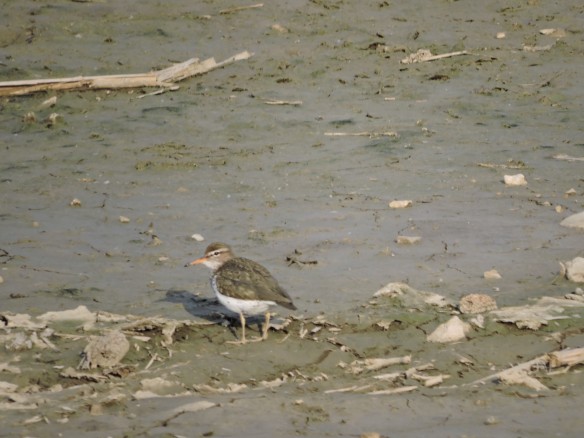
Spotted Sandpiper
Along the way, I found a Spotted Sandpiper sharing a flooded field with a bunch of Semipalmated Plovers. All were new green year birds, and shorebirds were a big hole in my list last year so it was good to pick them up.

Orchard Oriole
Around 9:00 I made it to Arrowhead Prairie way down in the southwest corner of Allen County. I immediately heard a Henslow’s Sparrow along the roadside there for my first really great bird of the morning. I couldn’t locate where it was singing from, but my consolation were several singing Orchard Orioles, the first ones on my green list in three years.

Field Sparrow
I took a break at Arrowhead and tallied my species, which numbered 52 without looking for any of the famous woodland migrants. A huge flock of Field Sparrows kept me company.

Fox Island
I made it back to Fox Island about an hour later, and by then the wind had really started to pick up, plus I had been riding almost constantly since 4:30, so it felt good to get off my bike and use some different muscles. The wind was great to keep the mosquitoes at bay, but it made hearing birdsong somewhat difficult. The ever increasing temperature didn’t make things any easier, either. But I had several target species to find, including my only real chance for Pileated Woodpecker and some great habitat (pictured above) for Prothonotary Warbler.
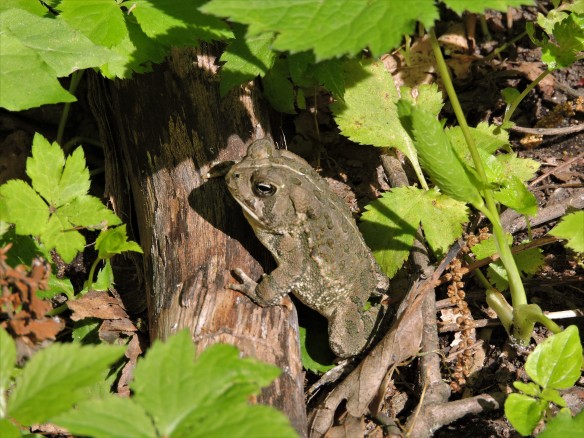
Toad
I struck out on both targets as well as almost all other possible additions to the list. I managed only five warbler species the whole morning. I resigned myself to looking at other things. Thankfully, I had a “then suddenly…” moment.

Black-billed Cuckoo
A cuckoo flew directly in front of me and perched pretty much right over my head. I expected it to be my first of the year Yellow-billed, but instead it was a lifer Black-billed! This quickly became the best bird of the day and gave me back some of my original optimism about the day.
Re-energized, I set out into the brushy prairie area of the park to try for one more possible specialty before departing. I played tapes of Yellow-breasted Chat to try and find that target bird. I got a response when a much larger bird popped up out of the bushes. Northern Mockingbird! This was a county bird for me. They are nothing to write home about downstate in Indiana, but they get exceedingly scarce the further north you go.
Having spent about four hours at Fox Island, the afternoon was progressing rapidly, and the wind was brutal with temperatures close to 90. This made for some weird birding. I was at 72 species with some really great and unexpected ones, but I was still completely lacking in common birds like Carolina Chickadee, House Finch, and every raptor.
Especially grateful for my earlier decision to play to the wind’s advantage, I headed northeast to Eagle Marsh for the second time. Riding mostly with the wind, the few turns I had to make against it were insane. On one stretch, I had to pedal as hard as I could downhill in low gear just to actually move. But when I turned my back to it, I blasted down the roads at almost the speed of traffic.

Dunlin
There was almost nothing happening on the mudflats except for some hilarious backwards-flying swallows trying and failing to deal with the wind. I managed only one new bird, Dunlin, but it was a dapper alternate bird and one that I missed last year.
Deciding to pick off my remaining possible birds one-by-one, I left Eagle Marsh and headed toward home via Foster Park. I managed to snag the always reliable Yellow-throated Warbler there, with one singing despite the heat. Then I rode the greenway back toward downtown to try and get a few more common birds on the list.

Magnolia Warbler
The only interesting thing I found on the greenway was a deceased Magnolia Warbler. Thankfully I did see a live one at Fox Island, and this one had no obvious signs of mortality. I suppose a cyclist could have hit it?

My final route
I made it home around 4:00 and managed to pick up two more species in the yard over the course of the evening: House Finch and Red-tailed Hawk, which ended up being my last bird of the day. In all, I covered 57.5 miles over the course of the day and ended at 77 species. I got some really good finds like the cuckoo and Henslow’s Sparrow, but I missed some embarrassingly easy ones like Carolina Chickadee, Green Heron, Great Egret, and American Kestrel. But the mark has officially been set for Allen County if not Indiana, and I have every intention of beating this number next year. Although I hope someone else does it first.
A really good May morning at Fox Island could land close to 100 species, and that is without any other stops. I don’t feel like weather was a disadvantage, though. If nothing else, my fuel and hydration strategy worked perfectly, and I felt no ill effects from physical exertion during the day or in those following.

